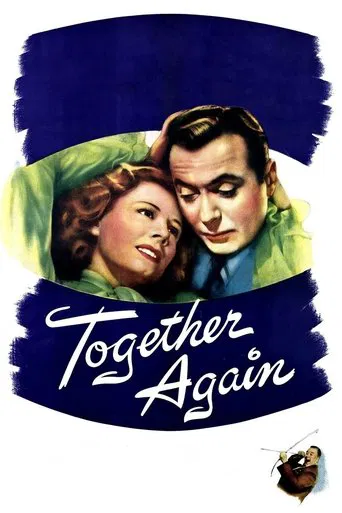

For his next photoplay, after "The Desperadoes", Charles Vidor requested Cover Girl (1944), primarily to show off his versatility, and having no idea at the time that it would eventually lead to his being typed (and principally thought of) as a director of musicals. Actually, Vicor much preferred his horror films, gothic romances and westerns. But with the exception of his masterpiece, Gilda (1946), these were now all behind him. (Thunder in the East, The Joker Is Wild, and even A Song to Remember and The Loves of Carmen, have Gothic overtones, but I think they may be excluded here). Entrancingly designed and inventively choreographed, Cover Girl was a hit from its smash opening sequence to its rousing finale. The only conventional thing about the movie was its screenplay -- a story in which Gene Kelly, Otto Kruger and Lee Bowman vied for the affections of Rita Hayworth. (You have just one single guess as to which of these three contenders won through in the end?)
... View MoreA comedy that seems out of place during World War II, this deals with a small town mayor (Irene Dunne) going to New York to interview a sculptor (Charles Boyer) about erecting a statue to her late husband to replace another one that for some reason was decapitated. Scandal finds her instead when he takes her to a notorious strip club that gets raided. He follows her back which gives her political rival (Charles Dingle) some ammunition to boot her out of office.Dunne and Boyer's third pairing is their only comedy and not a great one. It's sweet and pleasant, pleasantly acted, but lacking in energy. The delightful Charles Coburn once again steals every moment he is on screen as her old rascal of a father-in-law, anxious to see her re-married, presumably so his granddaughter by his son's first wife will stop pestering him. Coburn gets the kind of material that made him so amusing in the Jean Arthur films "The Devil and Miss Jones", "The More the Merrier" and "The Impatient Years".The stars do share chemistry, but when the story begins to get a bit serious, the interest comes to a grinding halt.Dunne is still able to perform a pratfall or two, looks lovely in a scene where she strips down to her negligee, and sings "I Get Ideas" in French charmingly. But when all is said and done, this is simply another variation of "Theodora Goes Wild" without the small-town parody present and as a result not nearly as funny.The love-starved stepdaughter briefly bogs the plot down with juvenile foolishness. When you've got professionals like Dunne, Boyer and Coburn, you really don't need anything else.
... View MoreAnne (Irene Dunne) lives with her father Jonathan (Charles Coburn) and her step-daughter Diana (Mona Freeman). She commissions a sculptor George (Charles Boyer) to work on a statue of her late husband. He moves into her garage to complete the work and romance is in the air. But for who.....? The film is a comedy/romance that is never funny. Charles Coburn provides most of the funny moments but there are far more irritating sequences, namely, whenever Mona Freeman or her boyfriend Gilbert (Jerome Courtland) are on screen. She needs a clout round the head and he plays a simpleton who annoyingly repeats "Goodnight" as his cool talk. This couple are a complete mis-match - she is intelligent and lively while he is slow and moronic - however, they are both very irritating so there is a common trait there. Irene Dunne pulls a few funny expressions but it's not enough to make this film good. It's just boring.........and Charles Boyer looks like a pudding.
... View MoreEven one of the most gifted and effervescent comediennes of Hollywood's golden era can't rescue the weak, silly (and sexist) script. Yet again Hollywood of the 1940s insists that a successful woman isn't complete, and can't be happy, unless she has a man - and invariably the plot is going to demand that she give up her career, because a relationship with a man is the only thing that matters. It's a premise that becomes increasingly hard to swallow as we get further and further away from the 1940s and 1950s. Charles Boyer plays the bohemian sculptor (who dresses like Saville Row) who she enlists to duplicate a statue of her husband, with graces the small town where she is Mayor, having succeeded her husband, who died. Charles Coburn is reliable comedic support, as her father-in-law, who relentlessly insists that her first womanly duty is to loosen up - in later years they'd say that she should get laid - and go for the man. There's a subplot about her precocious teen daughter, who falls for Boyer, and the daughter's lanky boyfriend, who then falls for Dunne. It's a duplicate set-up of an I Love Lucy episode a few years later. The film is forced, far-fetched, silly, basically unfunny. The stars struggle to bring a levity and wit that are simply missing from the dialogue, situations or premise. Dunne is so fetching, physically lovely, at the height of her beauty, and could deliver a line, arch an eyebrow, tilt her head, laugh, and make every man just fall in love with her, me included. She transcends an inferior script, not exactly enough to make the movie enjoyable, since it's mindlessly silly and predictable, and beneath the talents of the principal cast, but she is simply captivating. Charles Vidor also manages to inject some sparkle with his deft touch, to a sparkle-less script.
... View More